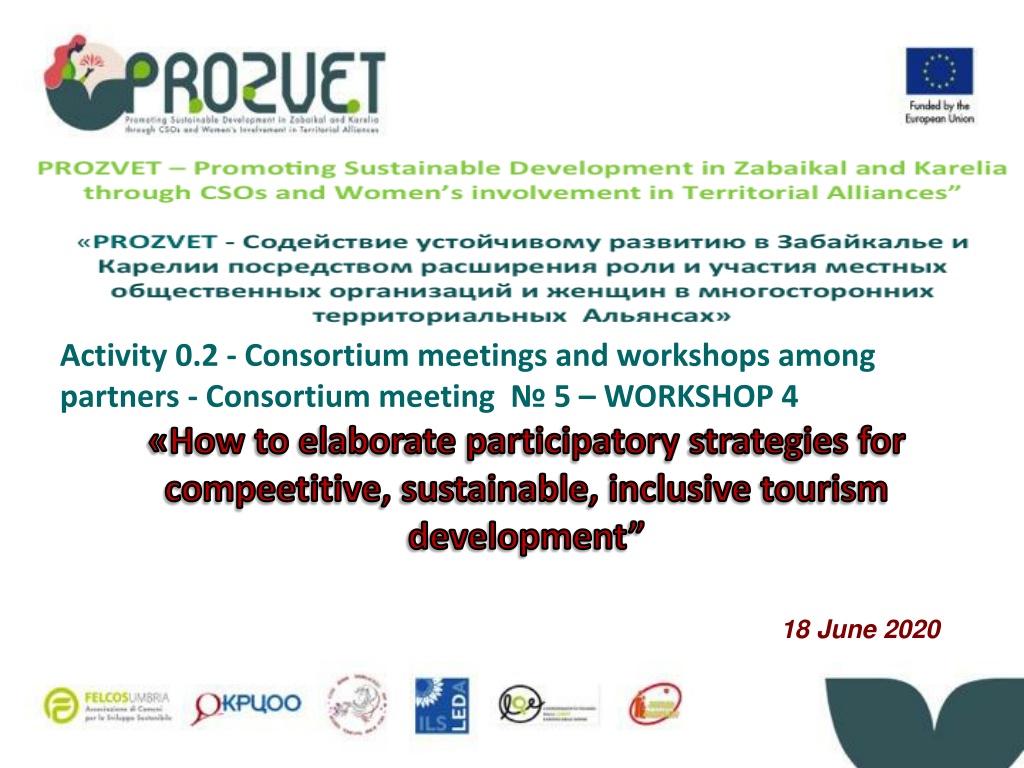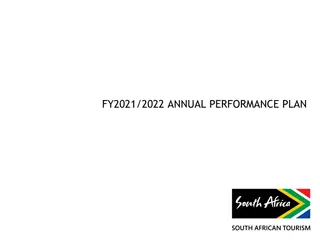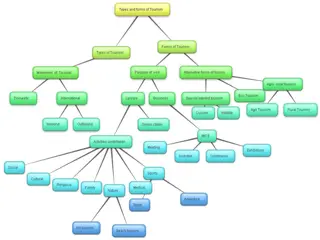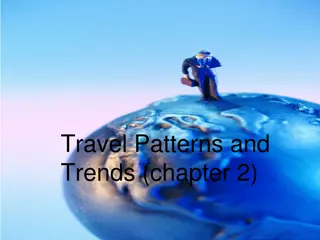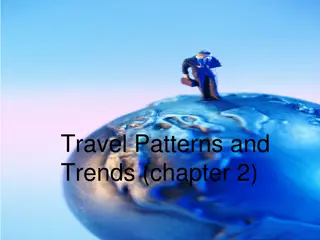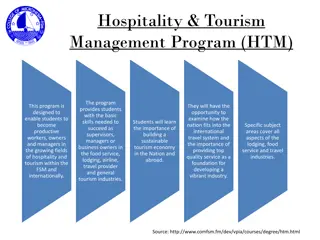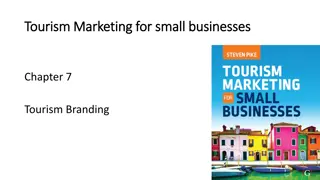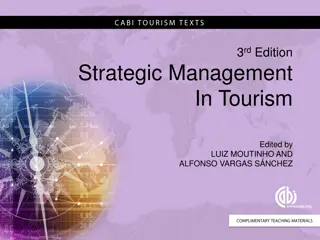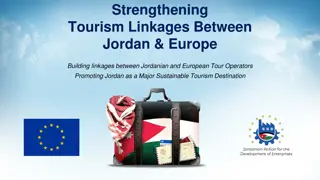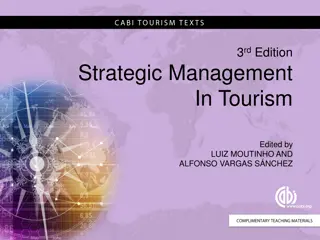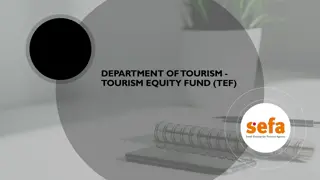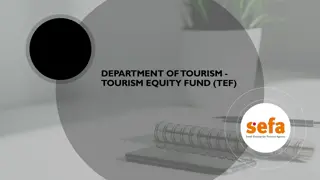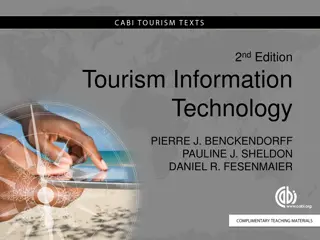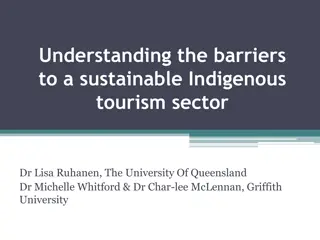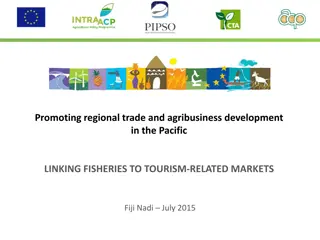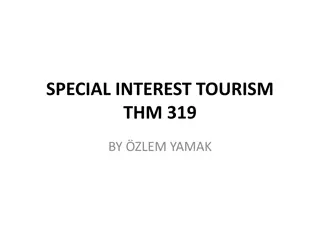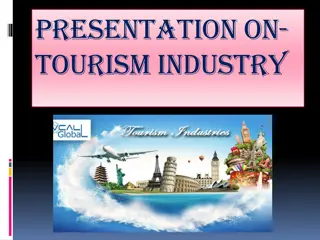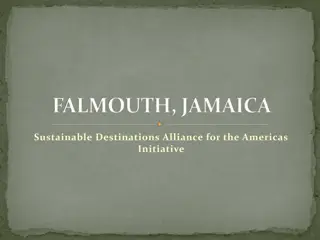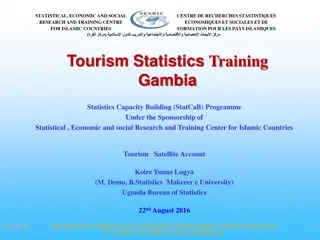Developing Participatory Strategies for Sustainable Tourism Growth
Explore the key topics discussed in a workshop focusing on developing participatory strategies for competitive, sustainable, and inclusive tourism development. Topics include the pillars of strategy elaboration, vision and mission, market positioning, Protvez methodology, and a case study on the Umbria region in Italy. The vision aims for the destination to be one of the top 10 tourism spots globally, while the mission targets improvements in tourist indicators. The strategy emphasizes competitive advantage, market positioning, and overcoming obstacles through long-term sustainability and social inclusion.
- Sustainable tourism
- Participatory strategies
- Market positioning
- Tourism development
- Inclusive growth
Download Presentation

Please find below an Image/Link to download the presentation.
The content on the website is provided AS IS for your information and personal use only. It may not be sold, licensed, or shared on other websites without obtaining consent from the author. Download presentation by click this link. If you encounter any issues during the download, it is possible that the publisher has removed the file from their server.
E N D
Presentation Transcript
Activity 0.2 - Consortium meetings and workshops among partners - Consortium meeting 5 WORKSHOP 4 How to elaborate participatory strategies for compeetitive, sustainable, inclusive tourism development 18 June 2020
What are the topics? 1. PILLARS FOR THE ELABORATION OF THE STRATEGY 2. VISION AND MISSION 3. THE COMPONENTS OF THE STRATEGY 4. BASIC ELEMENTS FOR THE MARKET POSITIONING 5. THE PROTVEZ METHODOLOGY FOR ELABORATING THE PARTICIPATORY TOURISM TERRITORIAL STRATEGY (RESCO) 6. THE CASE OF THE UMBRIA REGION IN ITALY (STRATEGY AND MARKETING)
PILLARS FOR THE ELABORATION OF THE STRATEGY FOR TOURISM VALUE CHAIN DEVELOPMENT AND WOMEN S EMPOWERMENT VISION MISSION OBJECTIVE COMPETITIVE ADVANTAGE MARKET POSITIONING STRATEGY OBSTACLES PLAN
THE VISION One of the first 10 tourism destinations Excellence In 10 years, we want our territory to be Russia Eastern Asia Europe World in Natural Adventure Experience Sport Historical Archaeological Health Congress Religious Youth As far as tourism
THE MISSION We want to achieve significant improvement of relevant indcators For instance Increase in tourist share of XX % in N years Increase of tourists overnights of NN % THE STRATEGIC OBJECTIVE To implement competitive, sustainable, and inclusive tourism strategies for women s inclusion in employment, self-employment and social entrepreneurship
THE STRATEGY COMPETITIVE ADVANTAGE MARKET POSITIONING OBSTACLES
THE STRATEGY. Long term competitiveness trough valorising the endogenous potential, the environmental sustanability, the social inclusion COMPETITIVE ADVANTAGE Identification and Assessment of the endogenous competitive factors Identification and Assessment of the sustainability factors Identification and Assessment of the women- inclusion factors Identification and Assessment of the tourism value chain strength and weaknesses
THE STRATEGY Positioning the territory according to an assessment referred to three variables MARKET POSITIONING Low Natural Adventure Experience Sport Historical Archaeological Health Congress Religious Youth Cost Standard Typology Russia Eastern Asia Neighbour Countries China Northern Europe Europe World Market
INTERNATIONAL TRENDS (PRE-COVID19) Request for standard performance of services, but characterised by originality, uniqueness, authenticity Demand trend at international level Sensitiveness for environmental quality and, especially from Northern European travelles, for ecologic products and services, that valorise the culture, traditions, and typical productions (food and artisan)
THE TOURISM IN RUSSIA (PRE-COVID19) In 2018, the number of tourists reached almost 60 million, which was more than a double of the 2010 value. 25 millions of them were international tourists. in 2018 the overnight stays counted a total of 584.08 million
THE RUSSIAN MARKET Push motivation items for Russian Tourists (2018) I would have a hassle-freeholiday 6.16 I would like to escape from a busy everyday life 6.00 There would be an opportunity to be together as afamily 5.37 I would have an opportunityfor physical rest 4.02 I would have a sense of comfort and pampering 5.36 I would have an opportunity to be physically active 4.33 I would have a memorable experience 6.22 I would like to relax away from the ordinary 5.26 I would have some control over the way things turn out 4.39 I would experience something new 5.53 I would experience aromantic holiday 4.68
Global Sample N=810 Interest for activities during rural holiday 37.0% Organized excursions to local sights / points of interest Familiarizing with local culture 28.4% INTERST FOR ACTIVITIES FOR RUSSIAN TOUSITS (2018) Going to sauna 39.9% Fishing 12.5% Hunting 3.6% Berry or mushroom gathering 8.3 % Swimming 33.3% Boating 10.2% Walking /hiking 23.6% Cycling 13.5% Horseback riding 17.9% Cross-country Skiing 7.3% Snowmobiling 9.1% Downhill skiing 7.2% Rafting 4.1% Water sport activities (e.g. hydro cycling, water skiing) 12.2% Indoor sport activities (e.g. tennis, badminton) 7.3% Paintball 4.2 % Wildlife watching 7.9%
THE STRATEGY Assessment and prioritisation of the obstacles that might hinder the achievement of the objective OBSTACLES Infrastructures Informations Services to tourists Business services Services for women empowerment Business to CSO Social services Entrepreneurs behavior and culture Entrepreneur know how Technological capital Networking Marketing Regulatory framework Obstacles to women empowerment
RESCO ANALYSIS EXISTING REGIONAL and MUNICIPAL PLANS PREVIOUS STUDIES AND RESEARCHES OWN MARKET ASSESSMENT THE INPUTS MARKET ASSESSMENT THE RESCO METHOD COMPETITIVE ECONOMIC DEVELOPMENT ADVANTAGE GENDER EQUALITY ASSESSMENT STRATEGIC ACTIONS POTENTIAL PLAN SUTAINABILITY * FACTORS ECONOMIC OBSTACLES VALUE CHAIN ASSESSEMENT SOCIAL ENVIRONMENTAL INSTITUTIONAL
THE OUTPUTS THE GOVERNANCE SYSTEM THE IMPROVEMENT OF THE VAUE CHAIN S PERFORMANCE THE IMPROVEMENT OF THE SERVICE SYSTEM (to tourists, tourist operators, and businesses) THE COMMUNICATION AND MARKETING STRATEGY
THE CASE OF UMBRIA REGION (ITALY) Tourism competitiveness COMPETITIVE ADVANTAGES Vast, diversified, quality and - most importantly - diffused cultural heritage A territory rich of history and traditions OBSTACLES Fragmentation of the tourism system Low developed Information and Communication Technology (ICT) systems Tourism marketing intelligence in need of improvement Insufficient collaboration among different economic sectors when it comes to co- marketing actions Networks of firms to develop thematic products Touristic image of Umbria to be better positioned and consolidated Unsatisfacory accessibility of the territory, intermodality and internal transportation system Old boroughs Beauty of landscapes Beauty of nature Autenticity and quality of life Welbeing and tranquility Enogastronomic culture and genuineness of the foodInformation and accommodation system for tourists Presence of a number of accommodation facilities that are outdated in terms of structures as well as managament Unsatisfactory lenght of tourists average stay Unsatisfactory levels of occupation of available beds / lodging Rural and urban historical buildings accessible to tourists Quality of accommodation Ability to satisfy a number of different holiday interests Competition among hotels excessively based on tariffs of accommodation Weakness of Umbria s tourist agencies system in supporting incoming tourism Substantial absence of international hotel chains Ability to offer options for niche tourism Increasing appreciation from foreign tourism markets Positive attitude of the local population and tourist operators towards incoming tourists Reduction of regional public funds destined to tourism
THE CASE OF THE UMBRIA REGION IN ITALY PILLARS OF THE STRATEGY GOVERNANCE HOSPITALITY SYSTEM MARKETING TOURIST OPERATORS CAPACITY BUILDING
THE CASE OF THE UMBRIA REGION IN ITALY Strategic guidelines Regional control room to synergize the activities of the various regional sectors and external structures: Regional Development Agency, Export Center, Agri-food Technology Park, tour operators Coordination committee for tourism promotion to coordinate and integrate the operations of all the actors/ components involved GOVERNANCE Regional System of Tourist Intelligence Regional observatory for tourism, as tool for tourism planning, for getting feedbacks from guests, and from (foreign) tour operators, acquiring data from external sources, gathering "unconventional" information on new tourism trends, and for managing the region s tourist web portal and social networks Regional tourism forum / blog , open to operators, and to serve as a room for sharing information and competences, in view to improve the tourist offer
THE CASE OF THE UMBRIA REGION IN ITALY Strategic guidelines A Regional Brand: Umbria, the green heart of Italy Marketing&Communication Local Agency Market antennas in Germany, Benelux, United Kingdom, United States of America On line promotion and web site MARKETING Participation in tourist fairs, workshops and other marketing events Flag ship events (Umbria Jazz, the Two-Worlds Festival, the Festa dei Ceri, Quintana Hourse Tournament, etc.) Photographic project "Sensational Umbria!"
THE CASE OF THE UMBRIA REGION IN ITALY - Strategic guidelines Technicaland financial support especially to innovative initiatives targeting at niche markets, and favouring business networks and other forms of aggregation between organisations IMPROVING THE TOURIST OPERATORS PERFORMANCE Support to promotion activities Support to information services Support to the start-up of creative tourist businesses, including in tourist accommodation, cultural, recreational, educational services, etc., and in communication and marketing; Support to the development of new professional skills (web designer, social media manager, ...) and co-working between stakeholders with different skills and resources
THE CASE OF THE UMBRIA REGION IN ITALY - Strategic guidelines Organisation and delivery of training on English language and techniques for managing relationships with tourists, to the enlarged system of service providers (city police, taxi and rental service operators, drivers and ticket staff, staff of road and rail transport services, newsagents, public car parks managers, museum managers, etc.) CAPACITY BUILDING Organisation and delivery of web and social marketing courses to improve web/social marketing skills of relevant staff of the toursim value chain Organisation and delivery of training to improve knowledge on the Region s territory and its tourism and cultural attractions
HOSPITALITY SYSTEM Multi level Multi actors Global reception system, that is, the network of actors providing information functioning as reception, representing territories or companies or consortia Focused on Services of Tourism Information and Hospitality (TIHO),and articulated on three levels Basic level; Basic Information, promotion, and orientation Intermediate level: Basic level + Planning of the tourists staying participation to marketing campaigns, intelligent Marketing Advanced level: Intermediate level + Organization and / or sale of services (bike and audio-guide rental, booking of service accommodation, or tourist cards); Display / sale of typical agri-food and handicraft products, merchandising
